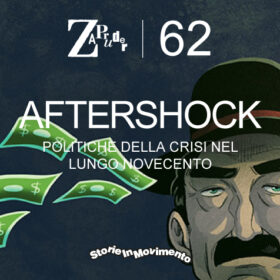Ripubblichiamo la call for papers di «Zapruder World» per il prossimo numero dedicato a musica e conflitto. Il numero verrà curato da Alessandro Pes e Tommaso Frangioni.
Scadenza: 30 giugno 2021
Contatto: submissions[at]zapruderworld.org
Introduction
Music has often been described as a “soundtrack” for social conflicts. However, as recent scholarship has begun to demonstrate, music’s role within social movements and conflicts runs much deeper than just sonic representation. Indeed, in both its auditory and lyrical forms, music has played a multifaceted role within many social movements, conflicts, and uprisings. Music has in fact often served as the primary social and cultural instrument through which conflicts have emerged and, over the much longer term, documented as historical experiences.
Aims and Objectives
Our aim with this seventh volume of Zapruder World is to open up a reflection on the relationship between music and social conflicts. Three main axes shape this analytical approach:
To begin, social conflicts can oftentimes be an incorporated issue within music. By this we intend to refer to all those acts that offer representations of struggles and conflicts, without being an expression of a specific political scene (i.e. combat-folk). This calls for a reflection on the territorialization of individual artists and groups, to explore the nexus between intentionality (in writing/performing a song that becomes an anthem) and inscription of meaning by those who listen. This perspective, therefore, invites reflection on the processes of mediation and symbolization, which offers the possibility for further exploring the primary elements through which such songs became anthems for social movements and/or conflicts.
The second axis concerns music born out of social conflicts. This perspective addresses music as a specific cultural product, carrying the “weight” of its origins in a context of social conflict, oftentimes tied to the class structure from which it emerged. Such an approach assumes, of course, that these structures are not necessarily clearly articulate, but can oftentimes be unconscious (i.e. working-class hip hop). This phenomenon has, in some cases, transferred to broader social and cultural movements (as was apparent with punk rock). Such a perspective implies an attention to the modalities of production, supply and listening, in order to develop an analysis of how social conflict is embedded in various forms of musical expression.
The third approach is represented by forms of musical expression that were consciously developed within a militant context and which seek to represent the struggles and other experiences of said social and political environments (i.e. Italian autonomist rap). Such an approach requires an examination of both explicit and implicit social and political meanings carried by the music in question, and their relationships with notions of collective identities. Music can be a useful tool for understanding conflict, as pointed out by John M. O’Connell (2010); we can understand conflict in terms of musical structure, practice, and context and can not only represent but also produce conflict. In this sense we intend to examine music in both ways.
Topics and Themes
A more specific, yet non-exclusive, list of themes we are interested in include the following:
- What is the relationship between musicians and the communities they cross? In particular, we are interested in examining the cases of musicians fleeing repressive governments, civil conflicts, wars, etc. Moreover, how do musical artists or groups grapple with the contradiction between any (relatively speaking) commercial successes and the accompanying expansion in their listening audiences, the vast majority of whom are far less likely to share the loaded values of the artist’s or group’s “early” recordings?
- What can the study of extreme right-wing musicians and musical groups and the communities orbiting around them tell us about the nature, and values, of contemporary neo-fascist political cultures?
- How can the study of “extreme” (considering both left and right) movements foster a better comprehension of social and political scenes? We often see a use of the term “scene” which fails to consider what their boundaries, their specificities, their embeddedness in specific time-spaces really are. And what can be said of the conflicts inside of these scenes in terms of the illumination of their boundaries?
- What perspectives can the critical study of music and musical cultures offer in comprehending the overlapping cycles of protest within nested and transcalar geographic realities (eg. the role played by Chilean street-music within the Italian feminist movement, Non una di meno (Not One Less)? What degree of contamination can we observe around the second axis, mentioned above, when the context changes, but the stylemes remain (more or less) the same (eg. the incorporation of motives of slave-chants in blues and rock)?
- What role do alternative marketplaces (i.e. the Do It Yourself ethic within the international punk rock movement during the 1970s and 80s) play within the successes of musical artists and groups that identify as “radical”? What are the potential contradictions that revolve around issues of musical production and distribution?
- What is the relationship between music and temporality? To what degree is the process of recuperating the anthems of the past serving to sustain and give key-words to present protests and social movements? How are both the past and the future deployed via music towards the establishment of new forms of unorthodox political theory and praxis? For instance, what are the possibilities explored, the scenarios opened—but also the risks—of specific treatments of the past (eg. the use of bluegrass, protest chants, and historical recordings in Panopticon’s Kentucky)? In short, what is the relationship between music and memory?
- In what ways has music been used as a tool for empowering destitute communities? On the other hand, how has music been deployed as the vehicle for disempowering and deflecting various social and political issues? This approach is particularly interesting when it can be used to observe conflicts surrounding the work of the same author/s (i.e. the conflicting opinions on Beyoncé: empowering black women or a “trojan horse” of free-market capitalism?), which opens up the issue of the positioning of both the artist/s and their audiences.
- How have music and lyrics served as “evidence” of past or contemporary social conflicts (such as in the legal trials in the United States during which hip hop lyrics have been used by the prosecution as “evidence” for an alleged crime (Kubrin and Nielson, 2014)?
The composite nature of the topics outlined above (something you listen to, but also something you “read,” something that creates a visual experience, and in some cases also something that has a distinctive materiality) calls for a multi-dimensional approach: Although our primary objective is to call for papers for this special issue of Zapruder World, we would also welcome audiovisual and creative materials that could be integrated into and help expand the scope of this collection of case studies. In addition to scholarly articles, in fact, we invite submissions of non-essay form original work, such as photo essays, videos, interviews, drawings, comics, songs, hyperlinks to online resources, multimedia, etc., both accompanying the articles themselves and as standalone contributions. We encourage authors to think about incorporating multimedia both into their pieces proposed for Zapruder World and in the sections we have created on the journal’s website (e.g. “Yesterday” and “Today“—see http://www.zapruderworld.org/past-volumes/ for more information).
Volume Deadlines & Schedule
Abstracts in English (250-500 words) shall be sent to submissions[at]zapruderworld.org by June 30, 2021. All contributors will be informed about the status of their abstract submission by July 15, 2021. Full articles (preferably 6,000-9,000 words) will be expected by October 15, 2021. The published volume will appear both on Zapruder World‘s website and as a typesetted, Open Access PDF by December 31, 2021.













